P.Grosz, G.Haddow, P.Shiemer Austro-Hungarian Army Aircraft of World War One
Oeffag 50.08 to 50.12
The four Oeffag-Saliger "high-performance" reconnaissance prototypes, designated 50.08 to 50.11 (Oeffag Type AF) and powered by a 185 hp Daimler engine, were designed by Ingenieurleutnant Karl Saliger. Work had begun in January 1917 when he came to Oeffag from Flars. By the time the contract was signed in May 1917, one prototype was already undergoing flight trials. In fact, by 19 March sufficient flight data had been gathered for Flars to report that the 50.08 prototype was unfit for field service because of dangerous flight characteristics. It was necessary for Saliger to redesign the wings with a new airfoil section and change the fin and rudder. The modified 50.08 was commissioned on 31 May 1917, and the flight evaluation was successfully completed by the end of June. Only the static load tests stood in the way of releasing the design for production.
The second prototype, 50.09, was expected to be ready for flight tests in early June 1917, after which it was scheduled for armament installation and firing trials in Fischamend. The fourth prototype, 50.11, was reported ready for flight trials in July 1917.
Oeffag test pilot Hans Matti flew the third prototype, 50.10, on the maiden flight on 28 June 1917. During a flight demonstration at Aspern on 16 July 1917, the 50.10, piloted by Matti with Saliger as passenger, went into a low altitude spin and crashed, killing both occupants. The court of inquiry recorded that the 50.10 "had functioned splendidly in the previous 38 flights" and the crash officially was attributed to pilot error. It should be noted that Matti's father investigated the crash and found that the control wires had been partially filed through. The culprit was never found. Bereft of Saliger's leadership, the proposed order of 48 Oeffag Type AF aircraft was cancelled by Flars.
Yet the program remained alive; perhaps there was some glimmer of hope that the Type AF could be brought up to production standard after all. Major structural changes were made to the Oeffag 50.08 and in September 1917, Hauptmann Fekete, a skilled test pilot, reported a top speed of 175 km/h (109 mph) - equal to the Albatros D.III fighter - but judged the flight characteristics as poor. Lengthening the fuselage was suggested but with Saliger gone, nothing more was done.
50.08, 50.09, and 50.11 prototypes were sent as instruction airframes to the mechanics school in Wiener-Neustadt in March 1918. 50.11 remained on flight status and crashed on 4 April 1918 at Weikersdorf.
According to Oeffag documents, the 50.12 biplane, also a Type AF, was powered by a 230 hp Hiero engine and had slightly increased wing area. Believed a replacement for the destroyed 50.10 prototype, the 50.12 is not mentioned in extant Flars records nor have photographs been found, although Oeffag performance records indicate that flight tests may have been carried out.
Oeffag 50.08 Specifications
Engine: 185 hp Daimler
Wing: Span Upper 9.50 m (31.17 ft)
Span Lower 9.50 m (31.17 ft)
Chord Upper 1.40m (4.59 ft)
Chord Lower 1.40 m (4.59 ft)
Maximum Speed: 176 km/hr (109 mph)
Climb: 1000m (3,281 ft) in 4 min 8 sec
Oeffag 50.10 Specifications
Engine: 185 hp Daimler
Wing: Span Upper 9.50 m (31.17 ft)
Span Lower 9.50 m (31.17 ft)
Chord Upper 1.40 m (4.59 ft)
Chord Lower 1.40 m (4.59 ft)
Gap 1.40 m (4.59 ft)
Stagger 0.23 m (0.77 ft)
Total Wing Area 24 sq m (258 sq ft)
General: Length 7.13 m 123.39 ft)
Height 2.64 m (8.66 ft)
Empty Weight 695.8 kg (1534 lb)
Loaded Weight 1066.8 kg (2352 lb)
Maximum Speed: 180 km/hr (112 mph)
Climb: 1000m (3,281 ft) in 4 min
Oeffag 50.12 Specifications
Engine: 230 hp Hiero
Wing: Span Upper 9.50 m (31.17 ft)
Span Lower 9.50 m (31.17 ft)
Chord Upper 1.50m (4.92 ft)
Chord Lower 1.50 m (4.92 ft)
Dihedral Upper 0 deg
Dihedral Lower 1 deg
Sweepback Upper 0 deg
Sweepback Lower 0 deg
Gap 1.50 m (4.92 ft)
Stagger 0.28 m (0.92 ft)
Total Wing Area 25.16 sq m (271 sq ft)
General: Length 7.13 m (23.39 ft)
Height 2.63 m (8.63 ft)
Track 2.07 m (6.79 ft)
Loaded Weight 1180 kg (2602 lb)
Maximum Speed: 182 km/hr (113 mph)
Climb: 4000m (13,124 ft) in 19 min 35 sec
Oeffag 50.15
The Oeffag 50.15 prototype, powered by a 230 hp Hiero engine, was under construction in October 1918. Further information is lacking.
E.Hauke, W.Schroeder, B.Totschinger Die Flugzeuge der k.u.k. Luftfahrtruppe und Seeflieger 1914-1918
50. Flugzeuge der Österreichischen Flugzeugfabrik A.G. (Oeffag) Wiener Neustadt
50.08 Oeffag DD Zweisitzer (Konstruktion Salinger) Dm 185
50.09 Oeffag DD Zweisitzer (Konstruktion Salinger) Dm 185
50.10 Oeffag DD Zweisitzer (Konstruktion Salinger) Dm 185
50.11 Oeffag DD Prototype für C.III (geplant) Dm 185
50.12 Oeffag DD
50.15 Oeffag DD H 230
 |
E.Hauke, W.Schroeder, B.Totschinger - Die Flugzeuge der k.u.k. Luftfahrtruppe und Seeflieger 1914-1918
|
| Oeffag D 50.08 Prototyp für zweisitziges Jagdflugzeug
|
 |
E.Hauke, W.Schroeder, B.Totschinger - Die Flugzeuge der k.u.k. Luftfahrtruppe und Seeflieger 1914-1918
|
| Oeffag C-Prototyp
|
 |
E.Hauke, W.Schroeder, B.Totschinger - Die Flugzeuge der k.u.k. Luftfahrtruppe und Seeflieger 1914-1918
|
| Oeffag C-Prototyp
|
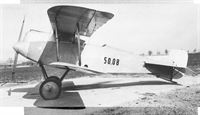 |
P.Grosz, G.Haddow, P.Shiemer - Austro-Hungarian Army Aircraft of World War One /Flying Machines/
|
The Oeffag 50.08 (first version) with small fin. Saliger took pains to design a compact, uncluttered airframe with a minimum of bracing and struts that was reminiscent of a single-seat fighter.
Oeffag 50.08 in Wr. Neustadt, Werksflugfeld 1917, Aufklärerprototyp, Konstruktion Ing. Saliger
Oeffag 50.08 в Wr. Нойштадт, заводской аэродром 1917 г., прототип разведчика, конструктор Салигер
|
 |
P.Grosz, G.Haddow, P.Shiemer - Austro-Hungarian Army Aircraft of World War One /Flying Machines/
|
| The Oeffag 50.08 (first version) prior to the maiden flight in February-March 1917. The airfoil radiator was unusual for an Austro-Hungarian two-seat aircraft.
|
 |
P.Grosz, G.Haddow, P.Shiemer - Austro-Hungarian Army Aircraft of World War One /Flying Machines/
|
| The Oeffag 50.08 (second version) fitted with a temporary tail fin of increased area and a new wing cellule, July 1917. As customary with prototypes, the observer’s gun ring remains to be installed.
|
 |
P.Grosz, G.Haddow, P.Shiemer - Austro-Hungarian Army Aircraft of World War One /Flying Machines/
|
| Oeffag 50.08 (third version) underwent major modification. The cabane section was opened to improve the pilot’s view, and a new fin and rudder were installed. The photograph at left was taken in August-September 1917.
|
 |
P.Grosz, G.Haddow, P.Shiemer - Austro-Hungarian Army Aircraft of World War One /Flying Machines/
|
| The Oeffag 50.08 (third version) was flight-tested in September 1917, demonstrating high speed but mediocre flight characteristics.
|
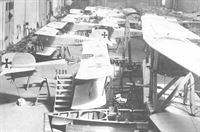 |
P.Grosz, G.Haddow, P.Shiemer - Austro-Hungarian Army Aircraft of World War One /Flying Machines/
|
| The Oeffag 50.09 prototype during final assembly in June 1917. Here it shares the large assembly hangar with the Oeffag K 423 flying boat and early production Albatros D.III(Oef) series 153 fighters.
|
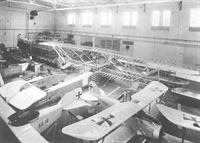 |
P.Grosz, G.Haddow, P.Shiemer - Austro-Hungarian Army Aircraft of World War One /Flying Machines/
|
| The death of Saliger and Matti in the crash of the Oeffag 50.10 prototype on 16 July 1917 effectively put an end to the Type AF program. The Oeffag 50.11 fuselage under construction is in the background and the completed 50.09 is behind the wings of the K 423 flying boat.
|
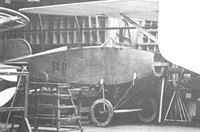 |
P.Grosz, G.Haddow, P.Shiemer - Austro-Hungarian Army Aircraft of World War One /Flying Machines/
|
| The unfinished Oeffag 50.11 awaiting completion in the factory. This prototype crashed on 4 April 1918, killing both occupants.
|
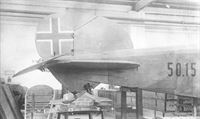 |
P.Grosz, G.Haddow, P.Shiemer - Austro-Hungarian Army Aircraft of World War One /Flying Machines/
|
| The only known photograph provides a tantalizing glimpse of the Oeffag 50.15 prototype, here under construction in October 1918.
|
 |
P.Grosz, G.Haddow, P.Shiemer - Austro-Hungarian Army Aircraft of World War One /Flying Machines/
|
| Wind tunnel model of the Oeffag Type AF tested in January 1917.
|
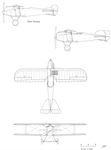 |
P.Grosz, G.Haddow, P.Shiemer - Austro-Hungarian Army Aircraft of World War One /Flying Machines/
|
| Oeffag 50.08
|















